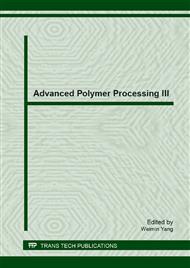[1]
Sheng Zhang, A. Richard Horrocks, A review of flame retardant polypropylene fibres, Prog. Polym. Sci. 28 (2010) 1517-1538.
Google Scholar
[2]
William H. Kohler, Anthony J. McHugh, Sensitivity analysis of low-speed melt spinning of isotactic polypropylene, Chem. Eng. Sci. 62 (2007) 2690-2697.
DOI: 10.1016/j.ces.2007.02.015
Google Scholar
[3]
Chenyang Yu, Ya Wang, Bingtian Wu, Yuhong Xie, Chun Yu, Shaohua Chen, Wenguang Li, Evaluating the foamability of polypropylene with nitrogen as the blowing agent, Polym. Test. 30 (2011) 887-892.
DOI: 10.1016/j.polymertesting.2011.08.014
Google Scholar
[4]
Saeed Asiaban, Siamak Moradian, Investigation of tensile properties and dyeing behavior of various polypropylene/polyamide 6 blends using a mixture experimental design, Dyes. Pigments. 92 (2011) 642-653.
DOI: 10.1016/j.dyepig.2011.05.019
Google Scholar
[5]
Lukas Sobczak, Reinhold W. Lang, Andreas Haider, Polypropylene composites with natural fibers and wood-General mechanical property profiles, Compos. Sci. Technol. 72 (2012) 550-557.
DOI: 10.1016/j.compscitech.2011.12.013
Google Scholar
[6]
Kathleen Van de Velde, Paul Kiekens, Effect of material and process parameters on the mechanical properties of unidirectional and multidirectional flax/polypropylene composites, Compos. Struct. 62 (2003) 443-448.
DOI: 10.1016/j.compstruct.2003.09.018
Google Scholar
[7]
L.G. Furlan, C.I. Ferreira, C. Dal Castel, K.S. Santos, A.C.E. Mello, S.A. Liberman, M.A.S. Oviedo, R.S. Mauler, Effect of processing conditions on the mechanical and thermal properties of high-impact polypropylene nanocomposites, Mater. Sci. Eng. A 528 (2011) 6715-6718.
DOI: 10.1016/j.msea.2011.05.044
Google Scholar
[8]
Senol Sahin, Pasa Yayla, Effects of processing parameters on the mechanical properties of polypropylene random copolymer, Polym. Test. 24 (2005) 1012-1021.
DOI: 10.1016/j.polymertesting.2005.07.010
Google Scholar
[9]
M. Modesti, A. Lorenzetti, D. Bon, S. Besco, Thermal behaviour of compatibilised polypropylene nanocomposite: Effect of processing conditions, Polym. Degrad. Stabil. 91 (2006) 672-680.
DOI: 10.1016/j.polymdegradstab.2005.05.018
Google Scholar
[10]
D. Dudic, V. Djokovic, D. Kostoski, The high temperature secondary crystallisation of aged isotactic polypropylene, Polym. Test. 23 (2004) 621-627.
DOI: 10.1016/j.polymertesting.2004.01.015
Google Scholar
[11]
Emmanuelle Koscher, Rene Fulchiron, Influence of shear on polypropylene crystallization: morphology development and kinetics, Polym. 43 (2002) 6931-6942.
DOI: 10.1016/s0032-3861(02)00628-6
Google Scholar
[12]
G. Tosello, A. Gava, H.N. Hansen, G. Lucchetta, F. Marinello, Characterization and analysis of weld lines on micro-injection moulded parts using atomic force microscopy (AFM), Wear 266 (2009) 534-538.
DOI: 10.1016/j.wear.2008.04.077
Google Scholar
[13]
Lei Xie, Monika Leester-Schadel, Gerhard Ziegmann, Stephanus Buttgenbach, Effect of physical vapor deposition metallic thin films on micro injection molded weld line mechanical properties, Microsyst. Technol. 16 (2010) 1009-1013.
DOI: 10.1007/s00542-010-1078-9
Google Scholar
[14]
J.G. Kovacs, B. Siklo, Experimental validation of simulated weld line formation in injection moulded parts, Polym. Test. 29 (2010) 910-914.
DOI: 10.1016/j.polymertesting.2010.06.003
Google Scholar
[15]
Emmanuelle Koscher, Rene Fulchiron, Influence of shear on polypropylene crystallization: morphology development and kinetics, Polym. 43 (2002) 6931-6942.
DOI: 10.1016/s0032-3861(02)00628-6
Google Scholar
[16]
Kaori Watanabe, Toshihiko Suzuki, Yuichi Masubuchi, Takashi Taniguchi, Jun-ichi Takimoto, Kiyohito Koyama, Crystallization kinetics of polypropylene under high pressure and steady shear flow, Polym. 44 (2003) 5843-5849.
DOI: 10.1016/s0032-3861(03)00604-9
Google Scholar
[17]
Lei Xie, Gerhard Ziegmann, Influence of processing parameters on micro injection molded weld line mechanical properties of polypropylene (PP), Microsyst. Technol. 15 (2009) 1427-1435.
DOI: 10.1007/s00542-009-0904-4
Google Scholar


